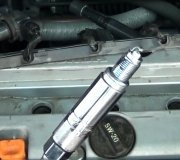No, you still have to have the wires routed properly. All the Engine Computer knows is it's firing the ignition coil. It has no idea which plug the high voltage is going to. As the distributor shaft turns, the rotor sends the voltage to the next plug in the firing order.
If you have the 4.0L inline 6 cylinder engine, the firing order is 1, 5, 3, 6, 2, 4. The terminals on the cap for cylinders 2 and 4 are toward the front with number 4 being next to the hold-down screw. The cylinders are numbered from 1 in the front to 6 in the rear.
If you have the V-8 5.2L (318 c.I.), The firing order is 1, 8, 4, 3, 6, 5, 7, 2. The cap terminal for cylinder 2 is toward the front. Next to it is the terminal for cylinder 1 which is next to the hold-down screw. The cylinder numbering on the engine is driver's side, 1, 3, 5, 7 from front to rear, and passenger side 2, 4, 6, 8, also front to rear.
Both distributor shafts turn clockwise. To add a little confusion, note that on the 5.2L, cylinders 5 and 7 are next to each other in the firing order and they're next to each other physically on the driver's side. When you clip the wires into the holder bracket on the valve cover, it's common for do-it-yourselfers to clip the wires in numerical order to make them look neat and pretty. That puts wires 5 and 7 side-by-side. The current flowing through one spark plug wire sets up a magnetic field around it which can "induce" a voltage into adjacent wires. That means it's possible for the spark to cylinder number 5 to electromagnetically cause a spark to occur at plug number 7 as it's on its way up on the compression stroke. This is much more of a problem on high performance engines with high output ignition systems and is a well-known cause of blown racing engines. That induced spark ignites the fuel WAY early in cylinder 7 and tries to make that piston go backwards. It is customary for mechanics to move the number 5 wire to the front of the wire holder and to move numbers 1 and 3 back a spot. It doesn't look quite as pretty but it keeps those two wires further apart just as a precaution.
Sunday, October 16th, 2011 AT 7:45 PM




